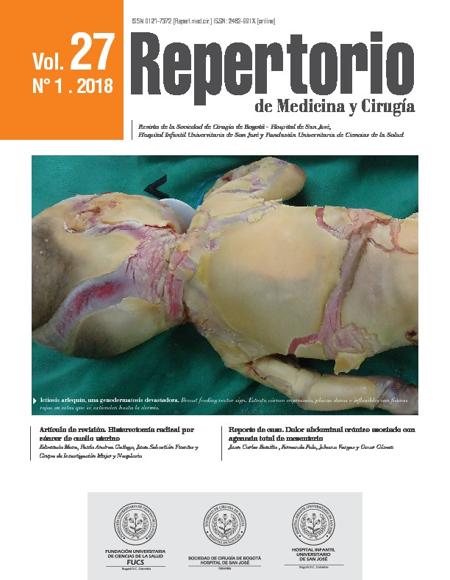Radical hysterectomy cervical cancer
Histerectomía radical por cáncer de cuello uterino
![]()
![]()

Show authors biography
Objective: To describe postoperative outcomes after radical hysterectomy in cervical cancer patients, between June 2007 and June 2017 at Hospital de San José in Bogotá. Materials and Methods: a retrospective review of radical abdominal hysterectomies for treating FIGO (International Federation of Gynecology and Obstetrics) stages IA2-IIA1 cervical cancer. Variables included clinical and pathologic features, and complications. Results: A total of 70 patients with mean age 45.5 years (SD 11.1) were included. Histology confirmed squamous cell carcinoma in 84.3% (n= 59) and adenocarcinoma in 15.7% (n=11). Average estimated blood loss was 700 cc (from 50 - 1000 cc, transfusion index was 12.9%, 9 patients). Intraoperative complications presented in 7 patients (9.9%) and included vascular injury in 5 patients, ureteral injury in one patient and serosal injury to sigmoid colon in one patient. Positive
surgical margins were detected in 7 patients (10%), lymph node metastases in 5 patients (8.6%) and parametrial involvement in 3 patients (4.3%). Tumor size was < 2 cm in 42 patients (60%), stromal invasion <1/3 in 42 patients (62.3%) and lymph node and vascular invasion in 18 patients (25.7%). One patient developed postoperative wound infection (1.4%), 3 presented bladder dysfunction (4.3%) and 23 required radiotherapy (32.8%). Conclusions: open radical surgery at Hospital San José includes an important volume of radical hysterectomies, comparable to that reported by other institutions with a similar complication rate.
Article visits 2399 | PDF visits 1039
Downloads
1. Ferlay J, Soerjomataram I, Ervik M, Dikshit R, Eser S, Mathers C, et al. GLOBOCAN 2012 v1.0, Cancer Incidence and Mortality Worldwide: IARC CancerBase No. 11 Lyon, France: International
Agency for Research on Cancer; 2013 [cited 2014]. Available from: http://globocan.iarc.fr.
2. Landoni F, Maneo A, Colombo A, Placa F, Milani R, Perego P, et al. Randomised study of radical surgery versus radiotherapy for stage Ib-IIa cervical cancer. Lancet. 1997;350(9077):535-40.
3. Trimbos JB, Franchi M, Zanaboni F, Velden J, Vergote I. 'State of the art' of radical hysterectomy; current practice in European oncology centres. Eur J Cancer. 2004;40(3):375-8.
4. Doll KM, Donnelly E, Helenowski I, Rosenbloom L, Small W, Schink JC, et al. Radical Hysterectomy Compared With Primary Radiation for Treatment of Stage IB1 Cervix Cancer. Am J Clin Oncol. 2012.
5. Dursun P, Gultekin M, Ayhan A. The history of radical hysterectomy. J Low Genit Tract Dis. 2011;15(3):235-45.
6. Malzoni M, Tinelli R, Cosentino F, Fusco A, Malzoni C. Total laparoscopic radical hysterectomy versus abdominal radical hysterectomy with lymphadenectomy in patients with early cervical cancer: our experience. Ann Surg Oncol. 2009;16(5):1316-23.
7. Monzon O, Rendon G, Echeverri L, Pareja R. Complicaciones asociadas a histerectomía radical con linfadenectomía pélvica en mujeres con cáncer de cérvix en el Instituto de Cancerología –Clínica Las Américas, Medellín, Colombia. Estudio de cohorte Revista Colombiana de Ginecología y Obstetricia2013. p. 46-52.
8. Taylor SE, McBee WC, Richard SD, Edwards RP. Radical hysterectomy for early stage cervical cancer: laparoscopy versus laparotomy. JSLS. 2011;15(2):213-7.
9. Pikaart DP, Holloway RW, Ahmad S, Finkler NJ, Bigsby GE, Ortiz BH, et al. Clinical-pathologic and morbidity analyses of Types 2 and 3 abdominal radical hysterectomy for cervical cancer. Gynecol Oncol. 2007;107(2):205-10.
10. Landoni F, Maneo A, Zapardiel I, Zanagnolo V, Mangioni C. Class I versus class III radical hysterectomy in stage IB1-IIA cervical cancer. A prospective randomized study. Eur J Surg Oncol. 2012;38(3):203-9.
11. Fanning J, Hilgers RD, Palabrica C. Surgical stapling technique for radical hysterectomy. Gynecol Oncol. 1994;55(2):179-84.
12. Covens A, Rosen B, Gibbons A, Osborne R, Murphy J, DePetrillo A, et al. Differences in the morbidity of radical hysterectomy between gynecological oncologists. Gynecol Oncol. 1993;51(1):39-45.
13. Frumovitz M, Sun CC, Schmeler KM, Deavers MT, Dos Reis R, Levenback CF, et al. Parametrial involvement in radical hysterectomy specimens for women with early-stage cervical cancer. Obstet Gynecol. 2009;114(1):93-9.
14. Suprasert P, Srisomboon J, Charoenkwan K, Siriaree S, Cheewakriangkrai C, Kietpeerakool C, et al. Twelve years experience with radical hysterectomy and pelvic lymphadenectomy in early stage cervical cancer. J Obstet Gynaecol. 2010;30(3):294-8.
15. Ryu SY, Kim MH, Nam BH, Lee TS, Song ES, Park CY, et al. Intermediate-risk grouping of cervical cancer patients treated with radical hysterectomy: a Korean Gynecologic Oncology Group study. Br J Cancer. 2014;110(2):278-85.
16. Piver MS, Ghomi A. The twenty-first century role of Piver- Rutledge type III radical hysterectomy and FIGO stage IA, IB1, and IB2 cervical cancer in the era of robotic surgery: a personal perspective. J Gynecol Oncol. 2010;21(4):219-24.
17. Sedlis A, Bundy BN, Rotman MZ, Lentz SS, Muderspach LI, Zaino RJ. A randomized trial of pelvic radiation therapy versus no further therapy in selected patients with stage IB carcinoma of the cervix after radical hysterectomy and pelvic lymphadenectomy: A Gynecologic Oncology Group Study. Gynecol Oncol. 1999;73(2):177-83.
18. Zullo MA, Manci N, Angioli R, Muzii L, Panici PB. Vesical dysfunctions after radical hysterectomy for cervical cancer: a critical review. Crit Rev Oncol Hematol. 2003;48(3):287-93.
19. Fei-Chi C, Hann-Chorng K. Urological Complications of Radical Hysterectomy for Uterine Cervical Cancer. Incont Pelvic Floor Dysfunct2007. p. 77-80.












